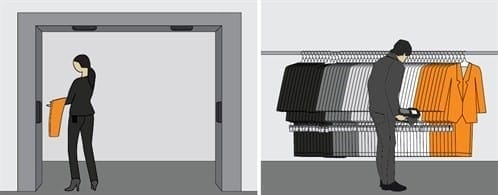The choice between fixed vs. handheld RFID readers is not always crystal clear. When investing in RFID technology in a retail setting, the most important thing is to choose the right device for your use case. That’s why Nordic ID RFID solutions are designed to fit existing, specific use cases, and not just as catch-all tools. For example, the same fixed RFID reader could be installed onto a wall or onto a trolley on wheels. Both are fixed readers by definition, but the other is still movable, and more suitable for smaller spaces.
RFID can be used throughout your retail brand’s entire value chain. In this article, our aim is to give you guidelines on a couple of use cases in which the choice between hand-held and fixed readers is especially relevant. These are:
- The supply chain
- The shop floor

SUPPLY CHAIN
Reading items during transport is not always necessary. Companies often rely on reading items at the following points:
- When leaving the distribution center, and
- Upon arrival at the store.
However, if the parcel moves from one vendor to another before arriving at the store, and if there is a reason to worry about shrinkage during transport, adding reading points will make sense. In the case of transport, the reading points should be mobile, so they can be moved from one vehicle to another and used wherever needed.
The main challenge for the use of handheld or wearable reading devices in transport vehicles is accessing the central database from the RFID device. Should the mobile unit save all information to its permanent memory and only update data when placed in the cradle? Or should all information be online, all the time?
Data security and transport
During transport, the upload and download of information will have to rely on mobile phone networks; typically, 3G, 4G, or Wi-Fi. Most available mobile devices have methods of handling data transmission over these networks, but you should plan around probable blind spots. The best units, for example, make sure the data is safe even when the network connection is down. However, different operating systems and device manufacturers have different methods for this. Therefore, it is important to choose an application for a mobile device that supports data security. Secured access to the database should carry no extra cost, no matter the device.
In general, all-in-one readers – handheld devices with integrated RFID readers – usually offer better performance than a mobile phone in combination with an external RFID reader enhancement.
THE SHOP FLOOR
Most RFID users combine handheld and fixed readers on the shop floor. Next, we’ll go over
USE CASES WHERE BOTH HANDHELD AND FIXED READERS ARE SUITABLE:
GOODS RECEIVING
Choose fixed when:
- The frequency of deliveries is high
- No space limitation
Further, choose installed fixed when:
- Designing a permanent portal
Or fixed on wheels when:
- You have design limitations – e.g. multiple entries or some space limitations
Choose handheld when:
- Receiving batches of 1-10 boxes a day
- You have limited space for the goods receiving process, or the size of the space varies greatly from store to store
- You want to use the same device for front-of-store and goods receiving
STOCK ROOM TO SHOP FLOOR
Choose fixed when:
- Minimizing human error is a priority
- Space is not a limitation
- Reliability is the top priority – well-placed fixed readers are more likely to give a more accurate read
Choose handheld when:
- Installing fixed readers is not possible – e.g. due to cabling, space limitations, or the location of the stock room
- Your stock size doesn’t make scanning by hand take significantly longer
RE-TAGGING / RE-WRITING ITEMS
Choosing handhelds or fixed readers depends on the process. When just re-writing information on existing tags, it is possible to use handheld devices to take care of the tag updates. When there is a regular need to create new tags, it might be more efficient to have a separate printer in the store. Typically, both the PoS application and handheld devices allow items to be re-tagged.
IN summary
Your specific use case, environment, and goals are the most important factors to consider when choosing between fixed or handheld solutions. Oftentimes, fixed and handheld readers are best used in parallel. The following are typical use cases in which you would initially lean towards one or the other as a starting point.
USE CASES BEST SUITABLE FOR HANDHELD DEVICES
Handheld devices are best suited for use cases where staff moves around on the shop floor and/or the tagged item could be anywhere in a specific area. Such applications are:
- Inventory & cycle count
- Locating items with the help of RFID
- For transport vehicles
- Delivery from online store directly to customer
USE CASES MOST SUITABLE FOR FIXED READERS
When RFID reading (and writing) always takes place in the same area, a fixed reader is a good choice. Such operations are:
- Distribution center/warehouse inventory management
- Point-of-Sale / Point-of-Exit – recognizing the items that are leaving the store
- Fitting room area – or other similar use cases, in which you want to recognize items taken to a specific area of the shop floor
Interested to learn more about how the user affects the reader? Check out our expert article.